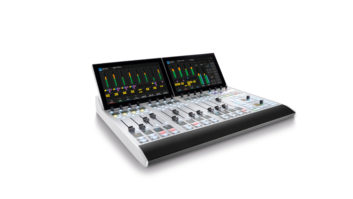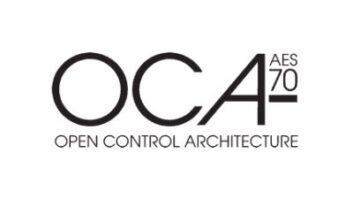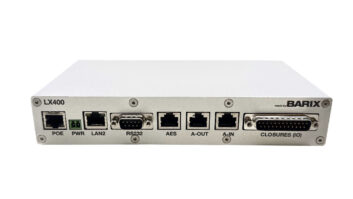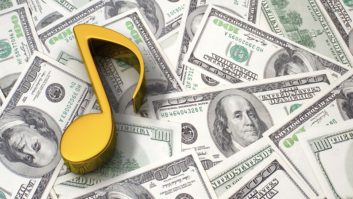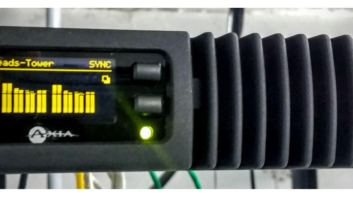PRODUCT CAPSULE
(click thumbnail)Instreamer-100
(click thumbnail)Exstreamer-100
Barix Instreamer and Exstreamer Audio Decoding Units
THUMBS UP:
Easy installation
Replaces expensive satellite dishes and leased dedicated lines (such as ISDNs require)
Reliable; impervious to viruses, worms and network dropout
Centralized management and monitoring
THUMBS DOWN:
Maximum of six simultaneous http MP3 streams per Instreamer
PRICE:
Instreamer, $395; Exstreamer (amplified), $395
CONTACT:
Barix Technology Inc. in Minnesota at (866) 815-0866 or visit http://www.barix.com
In the technology department, my home is generously appointed. It’s an electronic entertainment playground made possible by a mishmash of convoluted controls, tangles of wires and a half-dozen or so button-heavy oblique devices that require rote memorization. Cables are everywhere — some hidden, some bundled, most just a knotty mass stuffed behind my furniture or bulging noticeably beneath my rugs.
At my house, one does not simply sit down and turn on the TV.
Barix AG of Zurich, Switzerland addresses this familiar scenario in a miniscule, elegant way with its Instreamer-100 and Exstreamer-100 audio encoding products. These devices are based on TCP/IP (Internet protocol) and include an Ethernet connection to communicate over local networks and Internet with the ability to be managed by a standard Web browser.
Useful in both point-to-point applications at a single plant, and point-to-multipoint needs of a chain of facilities, the Barix Instreamer and Exstreamer hardware platforms “offer a reliable way of distributing real-time and on-demand audio over standard IP network infrastructures for a variety of audio applications,” claims Johannes Rietschel, CEO of Barix.
With these streaming components, audio can be distributed as easily between rooms in a building as between buildings across international borders and oceans.
Distributed
Using embedded stand-alone technology, the Instreamer-100 replaces a Mac, PC and audio encoding software. After converting analog and digital audio from sources such as tape players, tuners, digital disc players, turntables, audio preamps and computer audio into a mono or stereo MP3 stream, this data is then inserted into a network that is neatly distributed via Ethernet Cat-5 cables.
If you have a new building, these Ethernet wires are likely to be already run through the walls to each room of your facility. In existing buildings, these devices can be introduced at convenient points of an established network. The Instreamer has an integrated livestream Web server that acts like an Internet radio server and can serve streams by standard HTTP.
Audio equipment connection to the Instreamer is made simple by its providing stereo female RCA jacks for analog gear, and S/PDIF coax and optical connectors for digital equipment. It also can communicate with additional audio devices via onboard serial and IR ports. Supported bit rates are 32 kbps to 192 kbps with sample rates from 16 kHz to 48 kHz. The Instreamer is not vulnerable to viruses, worms or network dropouts that can plague encoding computers.
When many destinations are required, a “switch,” or network router, (inexpensive and easily available, just like the one you would use in your home) is the point of entry onto the network. I also can access each of the audio streams via the RS-232 serial ports located on the device.
If only one audio destination is required, the switch can be bypassed and a Cat-5 cable is used from the output of the Instreamer to a computer destination. The receiving computer would then simply launch an MP3 player such as Winamp or Windows Media Player, and the audio can be directed to speakers.
One Barix Instreamer is capable of providing up to six simultaneous http MP3 streams. If more than six streams are required, one method of increasing the number of listeners is to incorporate the free, downloadable SHOUTcast and Icecast servers, both supported by an Instreamer sporting firmware version 1.14 or newer.
You can predetermine the IP address or allow the Instreamer to detect one for you; it has a headphone jack on the front panel that examines the switch and announces an available address in a firm, friendly female voice. Write it down, type it into the address bar of your browser, and a network configuration page pops up with a few simple fields to fill.
For live broadcasting, the Instreamer eliminates the need for a computer. The audio can be streamed out directly to the Internet via a network router, and is configurable through a local or remote Web interface. This allows businesses to avoid substantial costs incurred using satellite or leased-line (ISDN) technologies.
Listen
Okay, I’ve got the audio converted to data and transferred to the Cat-5 cable and onto the network; now how do I get to hear the music in my house? Barix’s Exstreamer-100 finishes the journey.
This device is an intelligent network-based audio decoder that pulls digital audio (via that Cat-5 cable coming out of the Instreamer) from an IP network and converts it to analog audio — the box usefully proffering familiar stereo RCA female jacks and S/PDIF coax and optical digital connectors onboard the box. Hook up one Exstreamer to each pair of powered speakers and you’re done.
Do you have ceiling and soffitt-mounted speakers that aren’t self-powered? The Extreamer-100 version includes two 20-watt amplifiers in each unit to power them.
The Barix Exstreamer can be operated with an infrared (IR) remote control by utilizing the Barix IR Remote. The IR Remote lets IR commands be sent through your local network for home automation and control purposes. It is an Ethernet gateway that also offers IR output capability, allowing transmission of IR commands to IR controllable devices. With this embeddable IR Remote technology, it becomes possible to Web-enable almost any IR remote-controlled product, as well as many devices that allow management via serial control interfaces.
The IR Remote supports all common IR frequencies and codes as well as baseband (demodulated) transmission and reception (mainly for embedded or SONY S-Link/Control A1 II applications), and it transmits and receives all codes. Interfacing with home control software is easy through UDP, TCP, cgi and web-based Ethernet interfaces.








